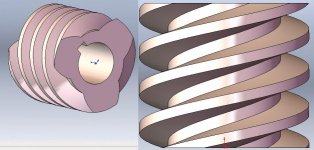copied from
this book ..
Using Two Tools
If the threading job is extensive, the threading tool would wear out very soon. In such a case, it might be more economical to use two different threading tools—one for roughing and the other for finishing. Even a slightly worn-out tool can be used as a roughing tool which should be used for all the threading passes except the last 2-3 passes, for which a finishing tool may be employed. Even a different RPM for the finishing tool might be used, if desirable. This would reduce the cost of tooling to a great extent, and at the same time, the quality of machining would also improve.
Shift in Threading Helix
A serious problem with using two tools is that, even if the start points are kept same, once the RPM and/or the tool is changed, the machine starts following a different threading helix which will spoil the thread. To overcome this problem, the operator will have to experimentally determine the axial shift of the helix when the second tool is used, and add/subtract (as appropriate) this amount to/from the initial axial position of the first tool, to determine the correct axial start position of the second tool. For example, if the first tool starts machining from Z = 10, and the helix of the second tool lies 1 mm to the left of the helix of the first tool, the start position of the second tool should be changed to Z = 11, to make the two helices coincide. The amount and the direction of the shift (left or right with respect to the helix formed by the first tool) can be found out by conducting a simple experiment, described next.
Measuring Shift in Helix
Consider the case of an M30 thread, for example. Take a workpiece of 30 mm diameter and run the following program with the first tool:
G00 X35 Z10;
M03 S200;
G92 X29.9 Z–10 F3.5;
This will just scratch a thin helix on the workpiece. Apply some color to it to differentiate it from the second helix to be made next. Now, run the same program with the second tool, without unclamping/re-clamping the workpiece. Another helix will be made. Using some accurate measuring device, such as a tool-makers’ microscope, measure the shift between the two helices, and also observe the direction of the shift.
Note that the experiment described above will need to be repeated for every outer diameter and every RPM. The RPM during the experiment must be the same as that in the original program. However, the RPMs for the two tools can be chosen to be different, if desired. Also, the entire threading operation, i.e., roughing and finishing, both should be done in the same setup. Once a partially threaded workpiece is unclamped and re-clamped, the same helix is not guaranteed in further machining. This also means that rework on a thread is not possible using conventional methods, once it is unclamped.





 )
)